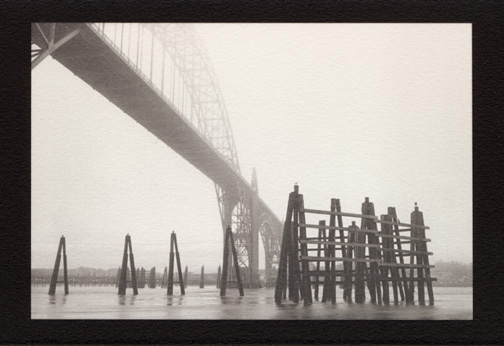
Contact Printing Paper |
 |
| 'Yaquina Fog' |
|
Emulsion making and research started out as a hobbyist's occupation. Reading the old literature, you can sense the excitement. They shared openly and gave credit freely. By 1900, give or take a few years, the literature dried up. In 1929, E. J. Wall wrote in Photographic Emulsions,
We are today in the same place as Wall in 1929, but every year we are losing the people and materials that are needed to bridge the gap between yesterday and tomorrow. If this research is allowed to languish much longer, the darkrooms will be gone. Yes, there will still be beautiful black and white photographs hanging in museums (or more likely, in private collections) and there will even be old darkroom technique books left to buy used, but the intimate, casual experience of working the materials will be gone. The bridge burned. Time's a wasting and secrets and egos are an unaffordable indulgence. Some final advice from Mr. Wall, which I echo:
Now, to the cooking. |
|
I. Getting Started
Tools and Materials: (Important note: No aluminum, copper, bronze, chromed or galvanized tools)
Materials for 'I♥':
Materials for 'Warm ♥':
April 4, 2010. Material Info Update - Fabriano Artistico papers: After a number of months of testing, I am convinced that Fab Art paper has been changed. I started out with Fab Art X-white HP paper four years ago and have coated just about every variety of emulsion imaginable on it. As ugly as some emulsions have been, one thing I felt confident in saying was that they were bullet-proof — no bubbling, frilling or lifting. That changed about four months ago. I started getting tiny bubbles of lifting emulsion during washing. I originally thought that one of my ingredients had gone old, but after replacing all of them, one by one, I did a whole range of paper samples again. With any given run of emulsion, only the Fabriano Artistico papers develop bubbles. I love Fab Art paper, so I pushed through for a work-around solution. Bubbles are eliminated, or at the least greatly reduced if I use hardening fixer and follow with a 'speed wash' protocol (short pre-wash, archival washing aid, shortened final wash, squeegee, dry). dwr |
|
Replace This Text in js
Replace This Text in js
|
Copyright © The Light Farm |